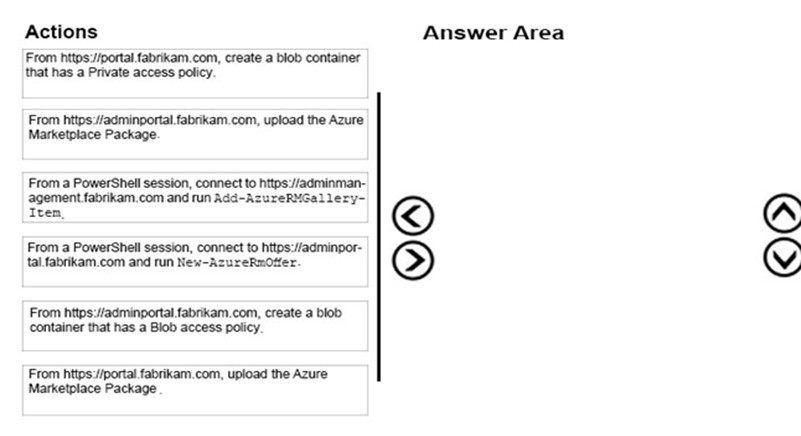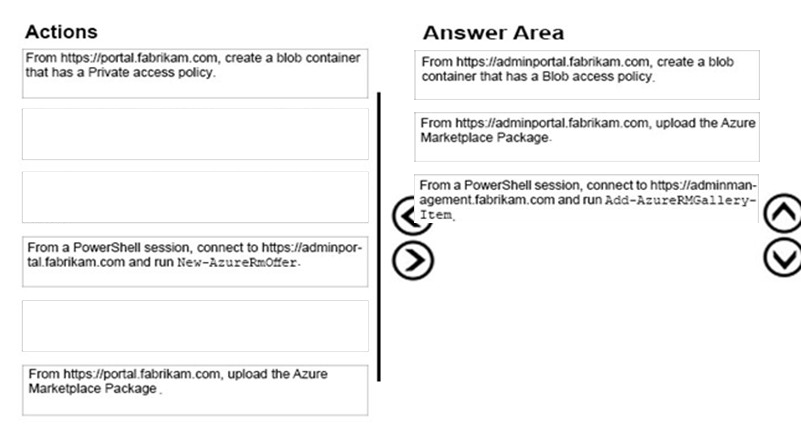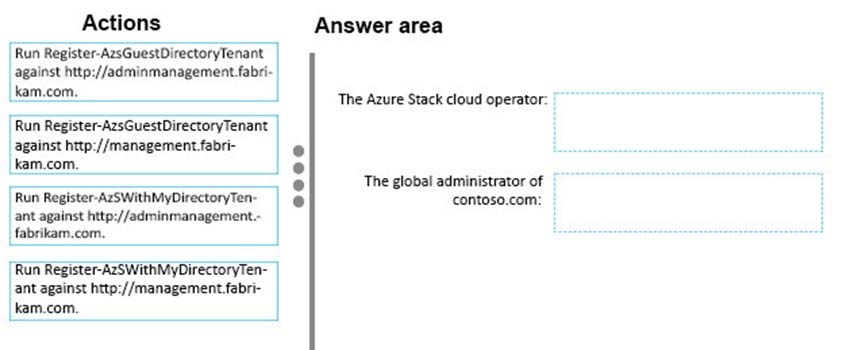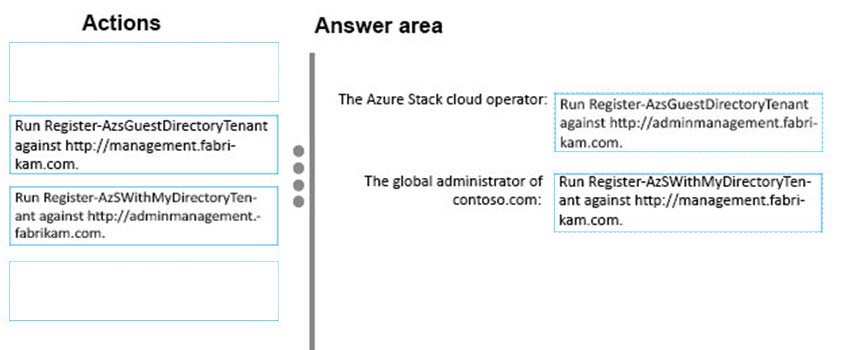Microsoft 70-537 Exam Practice Questions (P. 3)
- Full Access (67 questions)
- Six months of Premium Access
- Access to one million comments
- Seamless ChatGPT Integration
- Ability to download PDF files
- Anki Flashcard files for revision
- No Captcha & No AdSense
- Advanced Exam Configuration
Question #11
DRAG DROP -
You have an Azure Stack integrated system that uses the external domain name of fabrikam.com.
You need to publish an Azure Marketplace Package (.azpkg) file to the Marketplace.
Which three actions should you perform in sequence? To answer, move the appropriate actions from the list of actions to the answer area and arrange them in the correct order.
Select and Place:

You have an Azure Stack integrated system that uses the external domain name of fabrikam.com.
You need to publish an Azure Marketplace Package (.azpkg) file to the Marketplace.
Which three actions should you perform in sequence? To answer, move the appropriate actions from the list of actions to the answer area and arrange them in the correct order.
Select and Place:

Correct Answer:

1. Create a blob container. This is a temporary container but it must be publicly accessible.
2. Uploaded the package.
3. Publish the package using the Add-AzureRMGalleryItem cmdlet.
References: https://docs.microsoft.com/en-us/azure/azure-stack/azure-stack-create-and-publish-marketplace-item#publish-a-marketplace-item

1. Create a blob container. This is a temporary container but it must be publicly accessible.
2. Uploaded the package.
3. Publish the package using the Add-AzureRMGalleryItem cmdlet.
References: https://docs.microsoft.com/en-us/azure/azure-stack/azure-stack-create-and-publish-marketplace-item#publish-a-marketplace-item
send
light_mode
delete
Question #12
You have an Azure Stack integrated system that has 100 tenants.
You create a new offer that is Private.
You need to provide the offer to a tenant.
What should you do?
You create a new offer that is Private.
You need to provide the offer to a tenant.
What should you do?
- ADelegate rights to the tenant user, and then instruct the tenant user to create a new subscription.
- BCreate a new subscription, and then assign the subscription to the tenant.
- CRun the New-AzsOffer cmdlet, and then specify the tenant user account.
- DRun the Set-AzsUserSubscription cmdlet, and then specify the subscription of the tenant user.
Correct Answer:
B
When you create an offer, you must include at least one base plan, but you can also create add-on plans that users can add to their subscription. A subscription is how users access your offers.
After you create an offer, users need a subscription to that offer before they can use it.
You can create subscriptions for both public and private offers. If do not want your tenants to create their own subscriptions, make all of your offers private, and then create subscriptions on behalf of your tenants. This approach is common when integrating Azure Stack with external billing or service catalog systems.
After you create a subscription for a user, that user can log into the user portal and will find that they are subscribed to the offer.
Incorrect Answers:
A: As the Azure Stack operator, you can delegate the creation of offers and users to other users by using the delegation functionality.
C: The New-AzsOffer cmdlet creates an offer composing of the specified base plans and add-on plans.
D: The Set-AzsSubscription cmdlet modifies the current logged-in user's tenant subscription.
References:
https://docs.microsoft.com/en-us/azure/azure-stack/azure-stack-delegated-provider https://docs.microsoft.com/en-za/powershell/module/ azurerm.azurestackadmin/new-azsoffer?view=azurestackps-1.2.11 https://docs.microsoft.com/en-za/powershell/module/azurerm.azurestackadmin/set-azssubscription?view=azurestackps-1.2.11 https://docs.microsoft.com/en-us/azure/azure-stack/azure-stack-subscribe-plan-provision-vm
B
When you create an offer, you must include at least one base plan, but you can also create add-on plans that users can add to their subscription. A subscription is how users access your offers.
After you create an offer, users need a subscription to that offer before they can use it.
You can create subscriptions for both public and private offers. If do not want your tenants to create their own subscriptions, make all of your offers private, and then create subscriptions on behalf of your tenants. This approach is common when integrating Azure Stack with external billing or service catalog systems.
After you create a subscription for a user, that user can log into the user portal and will find that they are subscribed to the offer.
Incorrect Answers:
A: As the Azure Stack operator, you can delegate the creation of offers and users to other users by using the delegation functionality.
C: The New-AzsOffer cmdlet creates an offer composing of the specified base plans and add-on plans.
D: The Set-AzsSubscription cmdlet modifies the current logged-in user's tenant subscription.
References:
https://docs.microsoft.com/en-us/azure/azure-stack/azure-stack-delegated-provider https://docs.microsoft.com/en-za/powershell/module/ azurerm.azurestackadmin/new-azsoffer?view=azurestackps-1.2.11 https://docs.microsoft.com/en-za/powershell/module/azurerm.azurestackadmin/set-azssubscription?view=azurestackps-1.2.11 https://docs.microsoft.com/en-us/azure/azure-stack/azure-stack-subscribe-plan-provision-vm
send
light_mode
delete
Question #13
You plan to create a Linux virtual machine on an Azure Stack integrated system.
You download an Ubuntu Server image.
Which authentication method can use to access the Linux virtual machine by using SSH?
You download an Ubuntu Server image.
Which authentication method can use to access the Linux virtual machine by using SSH?
- AThe Extensible Authentication Protocol (EAP)
- Ba Kerberos token
- Ca service principal
- Da password
Correct Answer:
D
When you create you Linux VM via the portal or the CLI, you have two authentication choices. If you choose a password for SSH, Azure configures the VM to allow logins via passwords. If you chose to use an SSH public key, Azure configures the VM to only allow logins via SSH keys and disables password logins. To secure your Linux VM by only allowing SSH key logins, use the SSH public key option during the VM creation in the portal or CLI.
References:
https://docs.microsoft.com/en-us/azure/virtual-machines/linux/overview
D
When you create you Linux VM via the portal or the CLI, you have two authentication choices. If you choose a password for SSH, Azure configures the VM to allow logins via passwords. If you chose to use an SSH public key, Azure configures the VM to only allow logins via SSH keys and disables password logins. To secure your Linux VM by only allowing SSH key logins, use the SSH public key option during the VM creation in the portal or CLI.
References:
https://docs.microsoft.com/en-us/azure/virtual-machines/linux/overview
send
light_mode
delete
Question #14
DRAG DROP -
You have an Azure Stack integrated system that uses a Microsoft Azure Active Directory (Azure AD) tenant named fabrikam.com as the identity provider.
You need to onboard contoso.com as a guest directory tenant.
Which action should each role perform? To answer, drag the appropriate actions to the correct roles. Each action may be used once, more than once, or not at all.
You may need to drag the split bar between panes or scroll to view content.
NOTE: Each correct selection is worth one point.
Select and Place:

You have an Azure Stack integrated system that uses a Microsoft Azure Active Directory (Azure AD) tenant named fabrikam.com as the identity provider.
You need to onboard contoso.com as a guest directory tenant.
Which action should each role perform? To answer, drag the appropriate actions to the correct roles. Each action may be used once, more than once, or not at all.
You may need to drag the split bar between panes or scroll to view content.
NOTE: Each correct selection is worth one point.
Select and Place:

Correct Answer:

References: https://docs.microsoft.com/en-us/azure/azure-stack/azure-stack-enable-multitenancy

References: https://docs.microsoft.com/en-us/azure/azure-stack/azure-stack-enable-multitenancy
send
light_mode
delete
Question #15
You have an Azure Stack integrated system.
A tenant requires assistance managing a subscription.
The tenant needs to create a custom RBAC role definition.
What should you instruct the tenant to do?
A tenant requires assistance managing a subscription.
The tenant needs to create a custom RBAC role definition.
What should you instruct the tenant to do?
- AEstablish a PowerShell session to the Azure Resource Manager (user) endpoint. Run the New-AzureRmPolicySetDefinition cmdlet and the New-AzureRoleTemplate cmdlet.
- BEstablish a PowerShell session to the Azure Resource Manager (user) endpoint. Create a JSON file that contains the permission definitions. Run the New-AzureRmRoleDefinition cmdlet.
- CEstablish a PowerShell session to the Azure Resource Manager (administrator) endpoint. Create an XML file that contains the permission definitions. Run the New-AzureRmRoleDefinition cmdlet
- DEstablish a PowerShell session to the Azure Resource Manager (administrator) endpoint. Run the New-AzureRmPolicySetDefinition cmdlet and the New-AzureRoletemplate cmdlet.
Correct Answer:
B
The New-AzureRmRoleDefinition cmdlet creates a custom role in Azure Role-Based Access Control. Provide a role definition as an input to the command as a
JSON file or a PSRoleDefinition object.
Incorrect Answers:
A: New-AzureRoleTemplate creates web and worker role templates. This has nothing to do with RBAC.
C: The permission definitions should be contained in a JSON file, not an XML file.
D: New-AzureRoleTemplate creates web and worker role templates. This has nothing to do with RBAC.
References:
https://docs.microsoft.com/en-us/powershell/module/azurerm.resources/new-azurermroledefinition?view=azurermps-6.2.0
B
The New-AzureRmRoleDefinition cmdlet creates a custom role in Azure Role-Based Access Control. Provide a role definition as an input to the command as a
JSON file or a PSRoleDefinition object.
Incorrect Answers:
A: New-AzureRoleTemplate creates web and worker role templates. This has nothing to do with RBAC.
C: The permission definitions should be contained in a JSON file, not an XML file.
D: New-AzureRoleTemplate creates web and worker role templates. This has nothing to do with RBAC.
References:
https://docs.microsoft.com/en-us/powershell/module/azurerm.resources/new-azurermroledefinition?view=azurermps-6.2.0
send
light_mode
delete
All Pages
